REAGENTC is a command used to enable and disable the Windows Recovery Environment. Windows Recovery Environment is used to troubleshoot and fix boot issues on a Windows PC. When it is disabled, you cannot repair or reset your PC. Some users cannot enable the Windows Recovery Environment with the Reagentc command and they see REAGENTC.EXE: Operation failed or REAGENTC.EXE Operation failed, An error has occurred message.
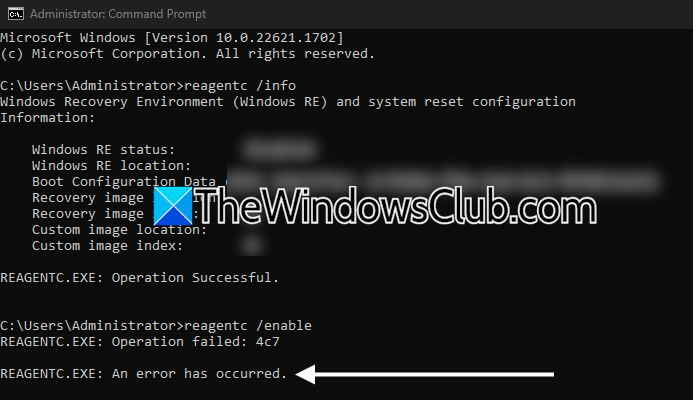
The complete error message is:
REAGENTC.EXE: Operation failed: <error code>
REAGENTC.EXE: An error has occurred.
The error code in the above error message can be different for different users, such as 2, 3, 5, 70, 4c7, 3ee, b7, etc. Whatever the error code, you can use the suggestions provided in this article to fix the problem.
REAGENTC.EXE Operation failed, An error has occurred
If you get the “REAGENTC.EXE Operation failed” error while enabling the Windows Recovery Environment on your system, with error code 2, 3, 5, 70, 4c7, 3ee, b7, etc. use these suggestions:
- Check the Recovery folder
- Repair your system image files
- Disable the Legacy BIOS and enable the Secure Boot (if applicable)
- Assign a new letter to the Recovery Partition
- Assign the correct ID to the System Partition
- Perform an In-place Upgrade or Clean Installation of Windows
All these fixes are explained below in detail.
1] Check the Recovery folder
Winre.wim file is the main file of the Windows Recovery Environment. If this file is missing or gets corrupted, you will not be able to use the Windows Recovery Environment. This file remains in use by Windows when the Windows Recovery Environment is active. Therefore, you cannot view it on your C drive even after enabling the hidden files and folders option. This file becomes visible only after disabling the Windows Recovery Environment.
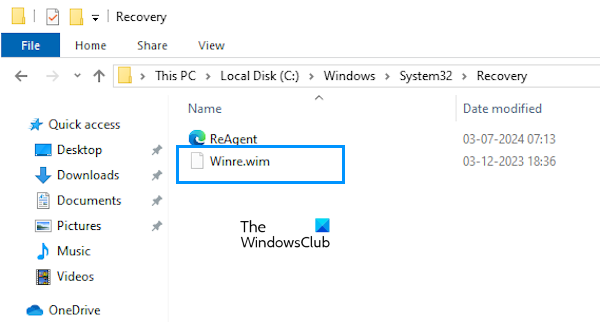
One possible cause of the “REAGENTC.EXE Operation failed” error while enabling the Windows Recovery Environment is the missing Winre.wim file. Open your C drive and go to the following location:
C:\Windows\System32\Recovery
Enable the hidden files and folders. See if the Winre.wim file is there. If the file is not there, you need to copy it from another healthy computer. Open another healthy computer (if available) and go to the same path as explained above to copy the Winre.wim file in your USB flash drive. Now, paste the file to the desired location on the affected computer.
If the file is already there on the affected computer, you can still try this method, as the file might be corrupted. In this case, select the replace option while copying the file to the affected computer.
Finding Winre.wim file in Installation Media
If another computer is not available to you, you can use the Windows Installation Media for the same. Install the Windows Media Creation Tool and use it to download the Windows ISO file. Now, mount the ISO file and open it. Open the Sources folder and locate the install.wim or install.esd file. Copy that file to another location on your hard drive. Now, use a third-party tool, such as 7 Zip to extract the file. This will take time.
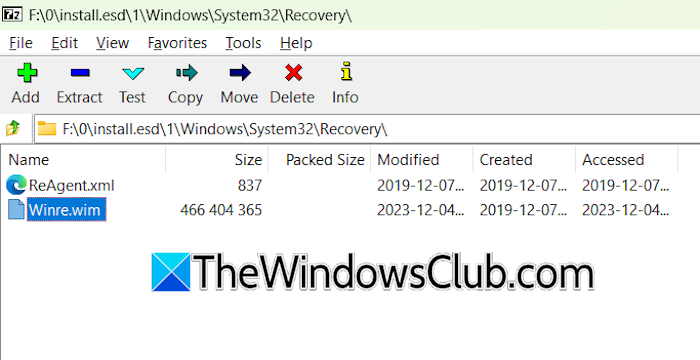
After extracting the file, open the extracted folder and go to the Windows\System32\Recovery location. You will find the Winre.wim file there. Copy that file to the desired location on your affected computer. Now, run the command to enable the Windows Recovery Environment. The command should execute without an error this time.
2] Repair your system image files
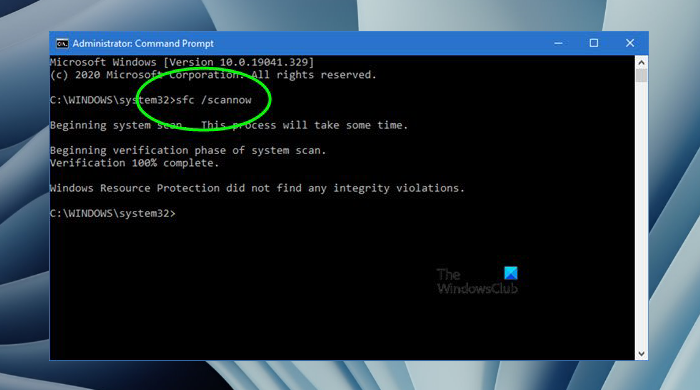
One possible cause of this error is the corrupt system image files. Use the built-in tools, System File Checker and DISM to repair the corrupted system image files.
3] Disable the Legacy BIOS and enable the Secure Boot (if applicable)
Enter your BIOS and see if the Legacy BIOS is enabled. If yes, disable it. The steps to disable legacy BIOS are different for computers of different brands. You need to refer to the user manual of your computer to know the right way to disable the Legacy BIOS mode.

You can also check the BIOS mode directly in the System Information app.
4] Assign a new letter to the Recovery Partition
Assign a new letter to the Recovery partition. Use the following instructions:
Click on Windows Search and type diskpart. Select the correct option in the search results to launch the Diskpart utility. Now, type the following commands and hit Enter after entering each command.
list disk select disk # list volume select volume # assign letter = K
In the above command, replace # with the correct disk and volume number. Now, type the following command and hit Enter:
reagentc /setreimage /path K:\Recovery\WindowsRE
The above command will update the ReAgent.xml file in the C:\Windows\System32\Recovery folder. Now, check the BIOS mode in the System Information app. If it is Legacy, change it to UEFI and also enable the Secure Boot. Restart your computer. You should be able to enable the Windows Recovery Environment this time.
5] Assign the correct ID to the System Partition
Another cause of this error is the incorrect GUID of the System Partition. Check this by following the steps provided below:
Launch the Command Prompt as an Administrator and type the following commands. Press Enter after typing each command:
diskpart list disk select disk # list partition select partition * detail partition
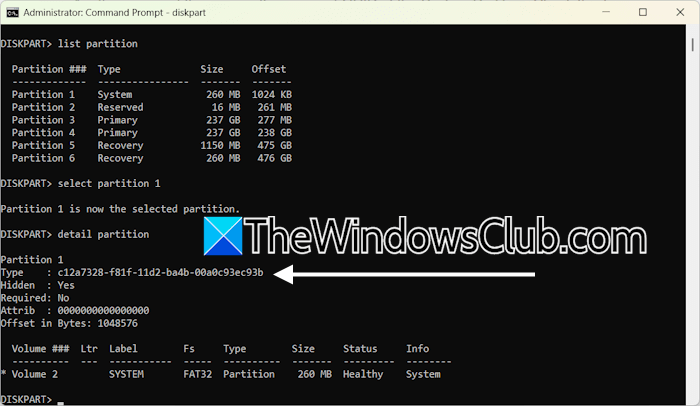
In the above commands, replace # with the correct disk number and * with the System Partition number. The Command Prompt should show the following GUID of the System Partition:
c12a7328-f81f-11d2-ba4b-00a0c93ec93b
If you see another GUID instead of the one mentioned above, you need to set the correct GUID for the System Partition. Now, select the System Partition (having the same partition number you used in the above commands).
select partition # set id=c12a7328-f81f-11d2-ba4b-00a0c93ec93b
Now, exit the Diskpart utility. After that, run the command to enable the Windows Recovery Environment. The command should execute without any error this time.
6] Perform an In-place Upgrade or Clean Installation of Windows
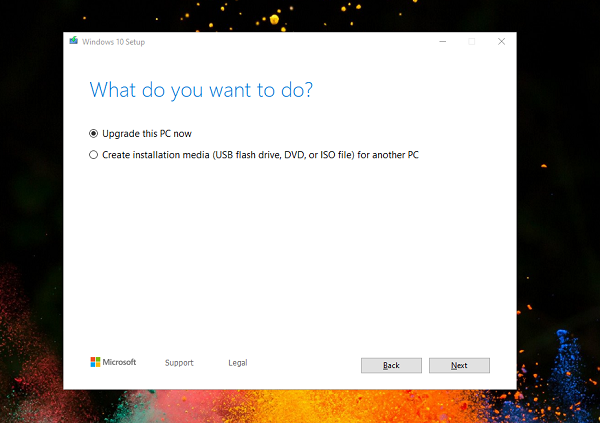
If nothing helped you, perform an In-place Upgrade. This process will install the Windows OS without uninstalling the currently installed Windows OS on your system. Hence, an in-place Upgrade repairs your system without deleting data. However, from a safety point of view, backup your data before proceeding.
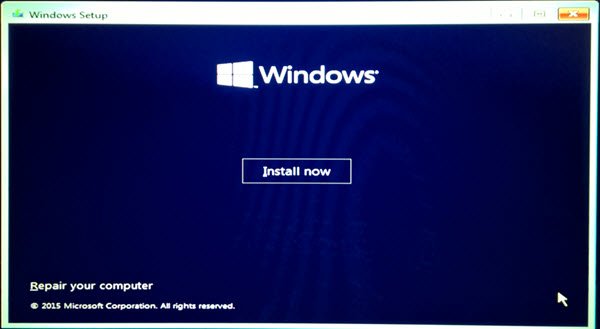
The last resort is to perform the Clean Installation of Windows. Before proceeding, backup your data on all hard drive partitions other than the C partition, so that if you format the incorrect hard drive partition, you will not lose your important files.
I hope this helps.
How do I fix REAGENTC.EXE Not found in Windows 11?
If you see the REAGENTC.EXE Not found error and your computer cannot find the Recovery Environment in Windows 11, when you try to enable Windows Recovery try to locate the WinRE image file which is called winre.wim. It is located in the C:\Windows\System32\Recovery folder. If it’s not there, you may need to extract it from a Windows installation media.
How to enable Windows RE Windows 11?
You can enable or disable WinRE in Windows 11 by executing the Reagentc command in the Command Prompt as an administrator. Launch the Admin CMD window and type reagentc /enable. Hit Enter after that.
What is the F12 boot menu?
The use of the F12 key is different in computers of different brands. For example, in some Lenovo computers, pressing F12 during startup brings up the boot menu, allowing users to choose a specific device. Refer to the user manual of your computer to know the exact function of the F12 key during system startup.
Read next: How to add Recovery Partition in Windows.